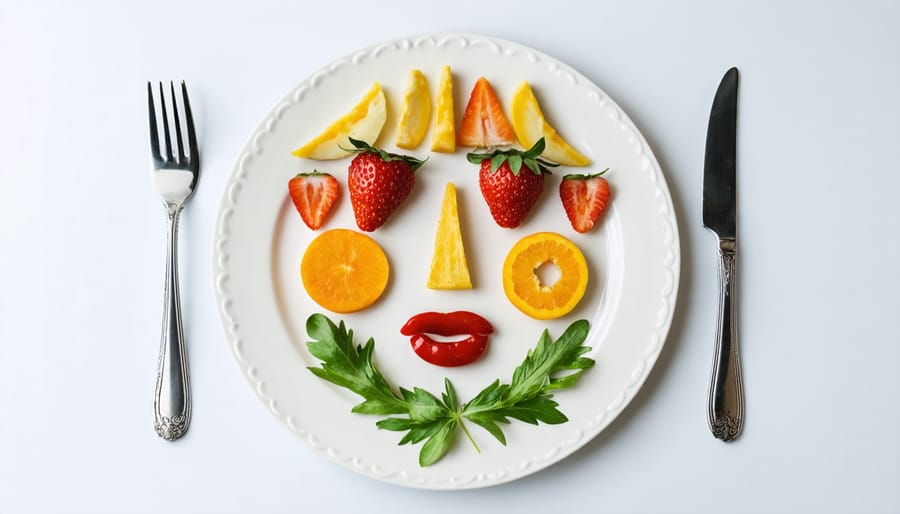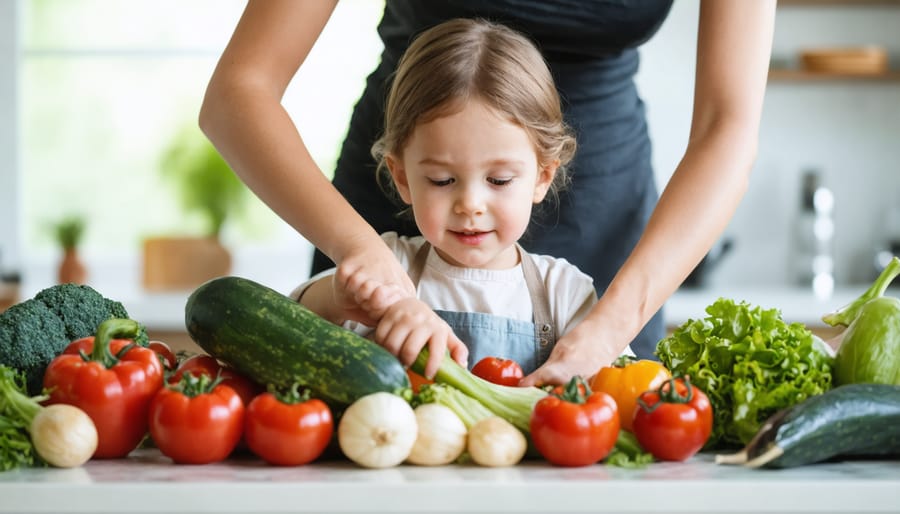
Transform your kitchen into a nutritional powerhouse where healthy eating meets family fun. Teaching children about nutrition doesn’t have to be a battle of wills – it’s an adventure waiting to unfold through colorful ingredients, hands-on cooking experiences, and delicious discoveries. As both a mom and certified nutritionist, I’ve witnessed countless picky eaters bloom into enthusiastic food explorers when given the right combination of education and engagement in the kitchen.
The connection between cooking and nutrition runs deeper than simply preparing meals; it’s about building lifelong healthy habits, understanding where food comes from, and developing a positive relationship with eating. When children participate in meal preparation, they’re more likely to try new foods and appreciate the importance of balanced nutrition. Plus, cooking together creates precious family moments while teaching essential life skills that will serve them well into adulthood.
Let’s explore practical, kid-friendly ways to make nutrition exciting and cooking accessible for the whole family.
The Psychology Behind Kid-Friendly Nutrition
Why Kids Resist New Foods
Ever noticed how your little one wrinkles their nose at new foods? You’re not alone! This completely natural behavior, known as food neophobia, typically peaks between ages 2 and 6. As a mom of two picky eaters, I’ve learned that children are naturally drawn to sweet and salty flavors while being cautious about bitter tastes – a prehistoric survival mechanism that helped our ancestors avoid potentially poisonous foods.
Children’s taste buds are also more sensitive than adults’, which explains why some flavors we enjoy might seem overwhelming to them. Plus, kids are hardwired to prefer familiar foods, making them hesitant to try new things. This isn’t just stubbornness; it’s their bodies’ way of staying safe while they learn about their environment.
Understanding these natural tendencies can help us approach mealtime with more patience and creativity, turning food exploration into an adventure rather than a battle.
The Power of Positive Food Experiences
Creating positive food experiences goes beyond just serving healthy meals – it’s about building joyful memories and associations with nutritious eating. Start by involving your children in meal planning and preparation, turning everyday cooking into engaging nutrition lessons for kids. Make mealtime a screen-free zone where family connections flourish through conversation and shared experiences.
Transform your kitchen into a space of discovery by encouraging taste tests of new ingredients and celebrating small victories when children try something new. Create themed dinner nights, like “Rainbow Tuesday” or “Around the World Thursday,” making healthy eating an adventure rather than a chore. Remember that children learn by example – when they see you enjoying nutritious foods with enthusiasm, they’re more likely to develop positive attitudes toward healthy eating themselves.
Consider starting a small herb garden together or visiting local farmers’ markets to help children understand where their food comes from, fostering a deeper connection with what they eat.
Kitchen Magic: Making Healthy Food Fun
Creative Presentation Tricks
Let’s transform ordinary meals into exciting culinary adventures! I discovered that presentation can make all the difference when my own picky eater suddenly became interested in broccoli because I arranged it like a tiny forest on her plate.
Start with color combinations that pop – try creating rainbow-themed plates using naturally colorful foods like cherry tomatoes, yellow bell peppers, and purple cabbage. For breakfast, transform plain pancakes into fun shapes using cookie cutters, or arrange fruit slices into smiling faces on yogurt bowls.
Bento-style lunch boxes are another game-changer. Use small silicone cups to separate foods and create themed arrangements – think underwater scenes with fish-shaped sandwiches and blue rice “waves.” For dinner, try the “food forest” approach: position steamed vegetables vertically in mashed potatoes to create an edible garden, or arrange rice and proteins in concentric circles for an eye-catching spiral effect.
Don’t forget garnishes! A sprinkle of sesame seeds can become “stars” on a dark plate, while fresh herbs make perfect “trees” in your food landscapes. Even simple touches like cutting sandwiches diagonally or using fun-sized vegetables can make meals more appealing.
Remember, presentation doesn’t have to be perfect – it’s about making food fun and engaging. Sometimes the most memorable meals are the ones where we let our creativity run wild!

Secret Veggie Recipes They’ll Actually Love
Getting kids to eat their vegetables doesn’t have to feel like a daily battle. As a mom who’s been there, I’ve discovered some clever recipes that turn healthy ingredients into dishes your little ones will actually request for seconds. Let’s dive into these parent-tested favorites that make stress-free family meals a reality.
First up is our “Rainbow Pizza” – a whole wheat crust topped with colorful bell peppers, carrots, and spinach, cleverly arranged in a fun pattern. The secret? A cauliflower-based white sauce that kids can’t distinguish from regular cheese sauce.
The “Hidden Treasure Mac and Cheese” is another winner, featuring pureed butternut squash and sweet potatoes blended into the cheese sauce. It’s creamy, delicious, and packed with vitamins that picky eaters won’t even notice.
Don’t overlook the power of fun names – our “Dragon Power Balls” (green smoothie-based energy bites) and “Superhero Muffins” (packed with zucchini and carrots) make healthy snacking exciting. The key is involving kids in the preparation process; they’re more likely to try foods they’ve helped create.
Remember, presentation matters. Try serving “Veggie Race Cars” made with celery sticks, carrot wheels, and hummus dip, or transform ordinary smoothies into “Magic Potions” by adding natural food coloring from beets or spinach. These simple tricks turn ordinary healthy foods into extraordinary adventures on a plate.
Getting Kids Involved in the Kitchen

Age-Appropriate Kitchen Tasks
Getting kids involved in the kitchen isn’t just fun – it’s a fantastic way to teach life skills and build confidence! I’ve found that matching tasks to age groups is key for both safety and success. For toddlers (2-3 years), start with simple activities like washing fruits, tearing lettuce leaves, or using cookie cutters on soft foods. They’ll feel like kitchen champions while staying safe!
Preschoolers (4-5 years) can graduate to stirring batters, mashing bananas, and helping to set the table. My daughter started kneading dough at this age, and it quickly became her favorite kitchen activity! School-age children (6-8 years) can measure ingredients, crack eggs, and even help with basic knife skills using child-safe utensils.
By ages 9-12, kids can usually handle more complex tasks like following simple recipes, using the microwave, and making sandwiches independently. Remember to always supervise and adjust these guidelines based on your child’s individual maturity level. The pride in their eyes when they create something in the kitchen makes it all worthwhile!
Making it Educational and Fun
Transform your kitchen into a colorful classroom where learning feels like play! I’ve found that involving children in meal preparation naturally sparks curiosity about food science, math, and nutrition. Start by letting little ones measure ingredients – it’s a perfect way to introduce fractions and counting. When my daughter helps me bake, we talk about how baking powder makes muffins rise, turning chemistry into a delicious experiment.
Create a “taste explorer” challenge where kids earn stickers for trying new vegetables, or turn your kitchen into a pretend cooking show where they can be the star chef. Keep a chart tracking the colors of fruits and vegetables they eat throughout the week, making it a fun competition to “eat the rainbow.”
For younger children, use cookie cutters to shape foods into exciting designs, or create silly faces on plates using different ingredients. You can even incorporate storytelling by crafting meals inspired by their favorite books or characters. Remember, when children feel ownership over their food choices and preparation, they’re more likely to embrace healthy eating habits naturally.
Building Healthy Habits That Last

The Family Meal Connection
In today’s fast-paced world, family meals have become more than just a necessity – they’re an invaluable opportunity to nurture both bodies and relationships. When we gather around the table, we’re not just sharing food; we’re creating lasting memories and establishing mindful eating habits that can shape our children’s relationship with food for years to come.
Creating a positive eating environment doesn’t require elaborate meals or picture-perfect table settings. It’s about setting aside distractions, engaging in meaningful conversations, and showing appreciation for the food and company. Try establishing regular mealtimes, even if it’s just a few nights a week, and involve everyone in the process – from meal planning to table setting.
I’ve found that some of my most cherished family moments happen during our weekend breakfast ritual, where we take turns choosing the menu and helping in the kitchen. These shared experiences not only strengthen family bonds but also naturally encourage healthy eating habits and food exploration. Remember, it’s not about perfection; it’s about creating a warm, inclusive space where food becomes a source of joy and connection.
Beyond the Kitchen
Bringing healthy eating to life extends far beyond your kitchen countertops. One of the most rewarding ways to connect with nutrition is by starting a small herb garden on your windowsill or backyard. Watching basil, mint, and parsley sprout from tiny seeds creates a magical connection to food that even the pickiest eaters can’t resist.
Make grocery shopping an educational adventure by turning it into a color-finding mission. Challenge yourself (and your kids, if you have them) to fill your cart with fruits and vegetables in every color of the rainbow. This simple game transforms routine shopping into an exciting treasure hunt while ensuring a diverse nutrient intake.
Take it a step further by visiting local farmers’ markets, where you can meet the people who grow your food and learn about seasonal eating. These face-to-face connections with farmers not only support your community but also deepen your understanding of where food comes from. Plus, there’s something incredibly satisfying about planning meals around what’s fresh and local rather than following rigid recipes.
Don’t forget to share your journey with friends and family – whether it’s trading homegrown herbs or organizing community potlucks featuring seasonal ingredients. These connections make healthy eating a shared adventure rather than a solitary pursuit.
Starting your family’s journey toward healthier eating doesn’t have to be overwhelming. By incorporating these simple strategies – from involving kids in meal planning to making food fun and colorful – you can transform mealtime from a struggle into an adventure. Remember, every small step counts, whether it’s introducing one new vegetable each week or letting your little ones help with simple kitchen tasks. The key is consistency and patience, not perfection. As you begin implementing these ideas, you’ll likely notice positive changes in your children’s attitudes toward food and nutrition. Most importantly, you’re building habits that will serve them well throughout their lives. So, grab those aprons, gather the family in the kitchen, and start creating delicious memories together. Your journey to healthier, happier mealtimes begins now!



